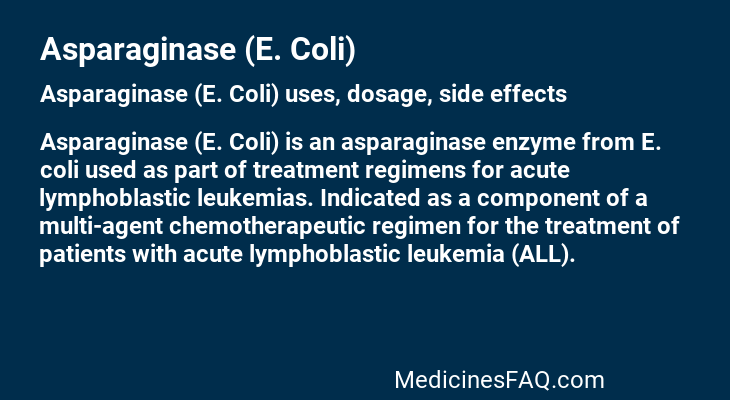Asparaginase (E. Coli)
Asparaginase (E. Coli) Uses, Dosage, Side Effects, Food Interaction and all others data.
Asparaginase derived from Escherichia coli (L-asparagine amidohydrolase, EC 3.5.1.1) is an enzyme responsible for the metabolism of L-asparagine, by catalyzing L-asparagine into L-aspartic acid and ammonia. It also facilitates the production of oxaloacetate which is needed for general cellular metabolism. Asparaginase from E. coli has clinically shown to exhibit antitumor actions in models of leukaemias . L-asparaginase of E. coli is marketed under several different trade names, including Elspar, for the treatment of acute lymphoblastic leukemia (ALL) as part of a multi-agent chemotherapeutic regimen. It is available as intramuscular or intravenous injections. Therapeutic L-asparaginase from E. coli works by depleting the levels of non-essential amino acid, asparagine, in lymphoblastic leukemic cells thus promoting apoptotic cell death . For patients who develop hypersensitivity to E. coli-derived formulations of L-asparaginase, the use of PEGylated or non-PEGylated Asparaginase Erwinia chrysanthemi is recommended .
In clinical trials of patients with previously untreated, standard-risk ALL, administration of asparaginase resulted in a decrease of plasma asparagine levels from average of 41 μM to less than 3 μM . The native asparaginase in whom plasma enzyme activity before treatment was greater than 0.1 International Units/mL . In this study, cerebrospinal fluid asparagine levels in patients treated with asparaginase decreased from 2.8 μM (pretreatment) to 1.0 μM and 0.3 μM at day 7 and day 28 of induction, respectively . Native E. coli asparaginase results in asparagine depletion in 14 to 23 days following administration .
| Trade Name | Asparaginase (E. Coli) |
| Generic | Asparaginase Escherichia coli |
| Asparaginase Escherichia coli Other Names | Asparaginase, Asparaginase (E. coli), Colaspase, Escherichia coli L-asparaginase, L-asparaginase, L-asparagine amidohydrolase |
| Type | |
| Formula | C1377H2208N382O442S17 |
| Groups | Approved, Investigational |
| Therapeutic Class | |
| Manufacturer | |
| Available Country | |
| Last Updated: | September 19, 2023 at 7:00 am |

Uses
Asparaginase (E. Coli) is an asparaginase enzyme from E. coli used as part of treatment regimens for acute lymphoblastic leukemias.
Indicated as a component of a multi-agent chemotherapeutic regimen for the treatment of patients with acute lymphoblastic leukemia (ALL).
Asparaginase (E. Coli) is also used to associated treatment for these conditions: Acute Lymphoblastic Leukaemias (ALL)
How Asparaginase (E. Coli) works
Asparagine is a non-essential amino acid that maintains DNA, RNA and protein synthesis and promotes cell growth. While healthy and normal cells are capable of obtaining asparagine via dietary intake or synthesizing the asparagine from aspartate via asparagine synthetase activity, lymphoblastic leukemic cells lack the asparagine synthetase enzyme and cannot produce asparagine de novo . Thus, leukemic cells rely on exogenous source of asparagine for protein synthesis and cell survival . L-asparagine from E. coli serves to deplete plasma levels of asparagine in leukemic cells by converting L-asparagine to L-aspartic acid and ammonia , leading to reduced reduced DNA, RNA and protein synthesis; inhibition of cell growth; and ultimately the activation of apoptotic cell-death mechanisms . Normal cells, however, are able to synthesize asparagine and thus are affected less by the rapid depletion produced by treatment with the enzyme asparaginase .
Toxicity
No studies assessing the mutagenic or carcinogenic potential of E. coli L-asparagine have been conducted. In the Ames assay, no mutagenic effect was demonstrated when tested against Salmonella typhimurium strains . No studies have been performed on impairment of fertility . Following a single, intravenous injection of 12,500 to 50,000 International Units L-asparagine/kg in rabbits, edema and necrosis of pancreatic islets were observed. The clinical relevance of this finding is unclear as it does not indicate pancreatitis .
Food Interaction
No interactions found.Volume of Distribution
Apparent volume of distribution was slightly greater than the plasma volume. Asparaginase levels in cerebrospinal fluid were less than 1% of concurrent plasma levels .
Elimination Route
In a study in patients with metastatic cancer and leukemia, daily intravenous administration of L-asparaginase derived from E. coli resulted in a cumulative increase in plasma levels. Following intramuscular injection in patients with metastatic cancer and leukemia, peak plasma levels of asparaginase was achieved 14 to 24 hours post-dosing .
Peak asparaginase activity of native E. coli asparaginase can be observed in 24 to 48 hours following administration .
Half Life
Plasma half life of L-asparagine derived from E. coli following intravenous injection was 8-30 hrs . Plasma half-life was 34 to 49 hours after intramuscular injection . Half-life (mean ± SD) of native E. coli asparaginase is approximately 1.28 ± 0.35 days .
Innovators Monograph
You find simplified version here Asparaginase (E. Coli)







